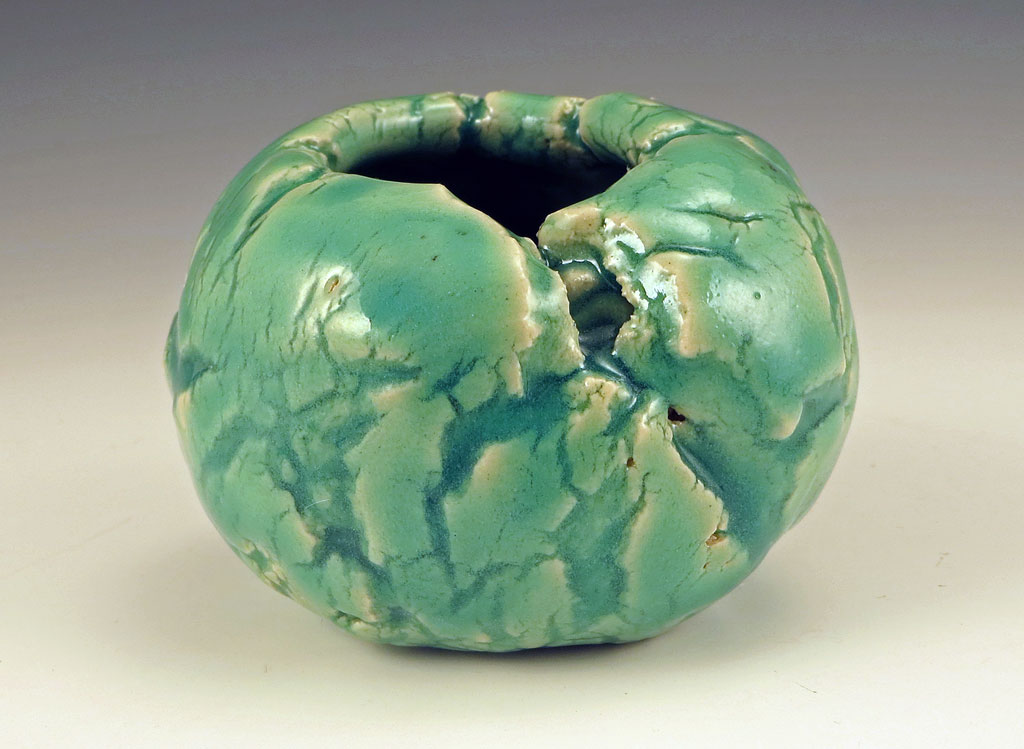
In my very first ceramics handbuilding class I sat at a large table which included a bunch of newbies like me plus one know-it-all wheel-thrower. I have not met a didact with a more tone-deaf need to expertsplain than hers. I was still in my Clay Wonder Years, falling in love and wanting to get lost in it. I relished how the outside surface of my pinch pots cracked as I expanded the clay from the inside creating intriguing organic possibilities. But my delight was soon doused with her continual instructions for crack banishment. I avoided her as much as possible, working outside on nice days and making full use of open lab time when she was not around. It took me awhile, but eventually I found the words to counter her: “Thank you, but I don’t learn by having the answers first, and, oh, I LIKE CRACKS!” I repeated it with a cheesy smile at every unasked-for comment and finally she quit schooling me and turned on the other hapless noobs.
Creative Dominatrices aside, this ceramics-and-cracks business is confounding. Sixteen years out from that class, I’m here to report there are two kinds of cracks: Unwanted and Honored. My tormentor obviously knew only of the Unwanted ones that are to be avoided, patched and camouflaged at every stage of the making and firing.
Frank and Janet Hamer’s venerable The Potter’s Dictionary of Materials and Techniques (Fourth Edition) devotes 8 1/2 fully-illustrated pages for the entry CRACK. (2), which details the appearance, behaviors and causes of raw, bisque and glaze cracks from A to T – that’s twenty distinctive types of cracks times three ways to get them! It’s no surprise that Unwanted Crack-phobia is alive and well. I, too, have my own arsenal of techniques and remedies to counter them.
But what about Honored Cracks? The special ones that are welcomed in both the clay and the glazes? There’s not much info on crack whispering out there, but let’s see what we can dig up. There is certainly crack cultivation in crackle and crawl glazes, especially Raku’s distinctive smoky lines which interestingly follow the form. It doesn’t happen often, but I have had some “problem” cracks transform into positive aesthetic elements as my workaround attempts led to seeing the piece in new ways. Then there is Kintsugi, the Japanese technique of repairing broken pottery by using metallic-dusted lacquer, often gold, which calls even more attention to the breaks and adds to the story of each piece. What am I overlooking?
In some rare words that honor cracks, Paulus Berensohn writes about hand-pinched pots in his book, Finding One’s Way with Clay,
The finished pot will show your finger marks. Because they are your fingers the pot will have a unique texture and you will probably want to have the marks remain. There may be a network of fine or strong cracks on the surface caused by the strong pressure of the thumb pressing the clay out from the inside. This texture, too, you may find pleasing and natural and earthlike, like the shells of some nuts.
Along with my study of wabi-sabi, Paulus B. never fails to calm me down and to help me see my making with tender vision and a broader perspective.
Since the beginning of the year, I have been walking around the studio and yard daily, meditatively pinching a small pot as a sort of warm-up to my day – like playing scales on the piano. I limit myself to only using my hands on these pieces, no tools of any kind. One morning I went to the end of my driveway with my ball of clay and before I could open it with my thumb a couple of old friends happened by. We chatted for a good half an hour, me still holding and turning the ball. When I finally came to forming my pot, the outside – which had gotten warmer and dryer by being held for so long – cracked more deeply and richly than anything I had made up to that point. It was a profound moment, as now I knew for certain sure not only how to honor the cracks that came, but how to elicit and emphasize them.
In closing, let me be a resentfully petty grudge-holding venter and say, “Neener-neener-neener, take THAT, Crack Police! And I’m lookin’ at you, Ms. Bossy-pants, cuz cracks crack me up.”
–Liz Crain, who will step away from her Studio Journal for a week because Mom is coming to town! In the meantime she will be mulling over Process/Product, Creating/Branding, Simplicity/Cleverness and mentally writing about them in preparation for a few new essays. If you don’t already get her bright and early Friday morning Journal entry emails – maybe you visit the link from Facebook, for example – you can always sign up right on this page. Thank you for being here.
That’s right, you tell ’em! Neener neener. Ha!
It was a long time coming!
I love “It Cracks Me Up” The shape! The color! The title! Your are amazing! Hugs, Pam & Daniel
Hugs right back at you both and thank you.
There is a similar japanese practice of repairing fabric/clothing/quilts called Boro, I believe. The idea is to emphasize the imperfection and elevate it.If it can be done is clay and fabric, might we try to apply that to human beings?
Yeah, stronger and more beautiful in the broken places.